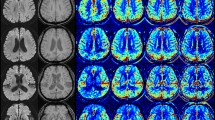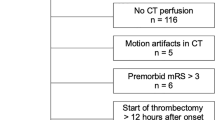Abstract
Purpose
This study aimed to verify the value of arterial spin labeling (ASL) collateral perfusion estimation for predicting functional outcomes in acute anterior circulation ischemic stroke.
Methods
This secondary analysis of an ongoing prospective observational study included data from participants with acute ischemic stroke due to steno-occlusion of the internal carotid artery and/or the middle cerebral artery within 8 h of symptom onset. We compared the collateral map, which is a 5-phase collateral imaging derived from dynamic contrast-enhanced magnetic resonance angiography, and ASL to validate the ASL collateral perfusion estimation. Multiple logistic regression analyses were conducted to identify independent predictors of favorable functional outcomes.
Results
One hundred forty-eight participants (68 ± 13 years, 96 men) were evaluated. The ASL collateral perfusion grade was positively correlated with the collateral perfusion grade of the collateral map (P < .001). Younger age (OR = 0.53, 95% CI = 0.36–0.78, P = .002), lower baseline NIHSS score (OR = 0.85, 95% CI = 0.78–0.92, P < .001), intermediate ASL collateral perfusion grade (OR = 4.02, 95% CI = 1.43–11.26, P = .008), good ASL collateral perfusion grade (OR = 26.37, 95% CI = 1.06–655.01, P = .046), and successful reperfusion (OR = 5.84, 95% CI = 2.08–16.42, P < .001) were independently associated with favorable functional outcomes.
Conclusion
ASL collateral perfusion estimation provides prognostic information, which can be helpful in guiding management decisions.




Similar content being viewed by others
Abbreviations
- ASL:
-
Arterial spin labeling
- CI:
-
Confidence interval
- CT:
-
Computed tomography
- DWI:
-
Diffusion-weighted imaging
- MCA:
-
Middle cerebral artery
- MR:
-
Magnetic resonance
- mRS:
-
Modified Rankin scale
- mTICI:
-
Modified thrombolysis in cerebral infarction
- NIHSS:
-
National Institutes of Health Stroke Scale
- OR:
-
Odds ratio
- SWI:
-
Susceptibility-weighted imaging
- Tmax:
-
Time-to-maximum
References
Liebeskind DS (2003) Collateral circulation. Stroke 34(9):2279–2284
Liebeskind DS (2005) Collaterals in acute stroke: beyond the clot. Neuroimaging Clin N Am 15(3):553–573
Shuaib A, Butcher K, Mohammad AA, Saqqur M, Liebeskind DS (2011) Collateral blood vessels in acute ischaemic stroke: a potential therapeutic target. Lancet Neurol 10(10):909–921
Kim SJ, Son JP, Ryoo S et al (2014) A novel magnetic resonance imaging approach to collateral flow imaging in ischemic stroke. Ann Neurol 76(3):356–369
Kim HJ, Lee SB, Choi JW et al (2020) Multiphase mr angiography collateral map: functional outcome after acute anterior circulation ischemic stroke. Radiology 295(1):192–201
National Institute of Neurological D, Stroke rt PASSG (1995) Tissue plasminogen activator for acute ischemic stroke. N Engl J Med 333(24):1581–1587
Hacke W, Kaste M, Bluhmki E et al (2008) Thrombolysis with alteplase 3 to 4.5 hours after acute ischemic stroke. N Engl J Med 359(13):1317–1329
Goyal M, Menon BK, van Zwam WH et al (2016) Endovascular thrombectomy after large-vessel ischaemic stroke: a meta-analysis of individual patient data from five randomised trials. Lancet 387(10029):1723–1731
Wufuer A, Wubuli A, Mijiti P et al (2018) Impact of collateral circulation status on favorable outcomes in thrombolysis treatment: a systematic review and meta-analysis. Exp Ther Med 15(1):707–718
Berkhemer OA, Jansen IG, Beumer D et al (2016) Collateral status on baseline computed tomographic angiography and intra-arterial treatment effect in patients with proximal anterior circulation stroke. Stroke 47(3):768–776
Venema E, Roozenbeek B, Mulder M et al (2021) Prediction of outcome and endovascular treatment benefit: validation and update of the mr predicts decision tool. Stroke 52(9):2764–2772
Menon BK, Smith EE, Modi J et al (2011) Regional leptomeningeal score on ct angiography predicts clinical and imaging outcomes in patients with acute anterior circulation occlusions. AJNR Am J Neuroradiol 32(9):1640–1645
Menon BK, d'Esterre CD, Qazi EM et al (2015) Multiphase ct angiography: a new tool for the imaging triage of patients with acute ischemic stroke. Radiology 275(2):510–520
Roh HG, Kim EY, Kim IS et al (2019) A novel collateral imaging method derived from time-resolved dynamic contrast-enhanced mr angiography in acute ischemic stroke: a pilot study. AJNR Am J Neuroradiol 40(6):946–953
Hartkamp NS, van Osch MJ, Kappelle J, Bokkers RP (2014) Arterial spin labeling magnetic resonance perfusion imaging in cerebral ischemia. Curr Opin Neurol 27(1):42–53
Grade M, Hernandez Tamames JA, Pizzini FB, Achten E, Golay X, Smits M (2015) A neuroradiologist’s guide to arterial spin labeling mri in clinical practice. Neuroradiology 57(12):1181–1202
Sogabe S, Satomi J, Tada Y et al (2017) Intra-arterial high signals on arterial spin labeling perfusion images predict the occluded internal carotid artery segment. Neuroradiology 59(6):587–595
de Havenon A, Haynor DR, Tirschwell DL et al (2017) Association of collateral blood vessels detected by arterial spin labeling magnetic resonance imaging with neurological outcome after ischemic stroke. JAMA Neurol 74(4):453–458
Lee S, Park DW, Kim TY et al (2020) A novel visual ranking system based on arterial spin labeling perfusion imaging for evaluating perfusion disturbance in patients with ischemic stroke. PLoS One 15(1):e0227747
Goyal M, Fargen KM, Turk AS et al (2014) 2c or not 2c: defining an improved revascularization grading scale and the need for standardization of angiography outcomes in stroke trials. J Neurointerv Surg 6(2):83–86
Miteff F, Levi CR, Bateman GA, Spratt N, McElduff P, Parsons MW (2009) The independent predictive utility of computed tomography angiographic collateral status in acute ischaemic stroke. Brain 132(Pt 8):2231–2238
Lansberg MG, Mlynash M, Hamilton S et al (2019) Association of thrombectomy with stroke outcomes among patient subgroups: secondary analyses of the defuse 3 randomized clinical trial. JAMA Neurol 76(4):447–453
Jansen IG, Mulder MJ, Goldhoorn RB et al (2019) Impact of single phase ct angiography collateral status on functional outcome over time: results from the mr clean registry. J Neurointerv Surg 11(9):866–873
Pan H, Lin C, Chen L et al (2021) Multiple-factor analyses of futile recanalization in acute ischemic stroke patients treated with mechanical thrombectomy. Front Neurol 12:704088
Souza LC, Payabvash S, Wang Y et al (2012) Admission ct perfusion is an independent predictor of hemorrhagic transformation in acute stroke with similar accuracy to dwi. Cerebrovasc Dis 33(1):8–15
Zaro-Weber O, Moeller-Hartmann W, Heiss WD, Sobesky J (2010) Maps of time to maximum and time to peak for mismatch definition in clinical stroke studies validated with positron emission tomography. Stroke 41(12):2817–2821
Huang YC, Liu HL, Lee JD et al (2013) Comparison of arterial spin labeling and dynamic susceptibility contrast perfusion mri in patients with acute stroke. PLoS One 8(7):e69085
Lyu J, Duan Q, Xiao S et al (2023) Arterial spin labeling-based mri estimation of penumbral tissue in acute ischemic stroke. J Magn Reson Imaging 57(4):1241–1247
Bivard A, Krishnamurthy V, Stanwell P et al (2014) Arterial spin labeling versus bolus-tracking perfusion in hyperacute stroke. Stroke 45(1):127–133
Okell TW, Harston GWJ, Chappell MA, Sheerin F, Kennedy J, Jezzard P (2019) Measurement of collateral perfusion in acute stroke: a vessel-encoded arterial spin labeling study. Sci Rep 9(1):8181
Acknowledgements
This study was supported by a National Research Foundation of Korea (NRF) grant from the Korean government (No. NRF-2020R1F1A1071619, RS-2023-00248375, RS-2023-00252980, and RS-2023-00266130).
Funding
This study was supported by a National Research Foundation of Korea (NRF) grant from the Korean government (No. NRF-2020R1F1A1071619, RS-2023-00248375, RS-2023-00252980, and RS-2023-00266130).
Author information
Authors and Affiliations
Contributions
Guarantors of the integrity of the entire study, T.-J. L., S. B. L., H. G. R., H. J. Kim.; study concepts/study design or data acquisition or data analysis/interpretation, T.-J. L., S. B. L., H. G. R., H. J. Kim., H. J. Ki, Y. S. J., J. S. L.; manuscript drafting or manuscript revision for important intellectual content, all authors; approval of the final version of the submitted manuscript, all authors; agreement to ensure any questions related to the work are appropriately resolved, all authors; literature research, T.-J. L., S. B. L., H. J. Kim, H. G. R.; clinical studies, T.-J. L., S. B. L., H. G. R., H. J. Kim, Y. S. J., H. J. Ki, J. J. P., H. J. L., S. Y. R., Y. J. J.; technical support (experimental studies), H. G. R., J. W. C.; statistical analysis, J. S. L.; and manuscript editing, T.-J. L., S. B. L., H. G. R., H. J. Kim
Corresponding author
Ethics declarations
Conflict of interest
The authors declare no competing interests.
Ethical approval
The local institutional review boards of Konkuk Medical Center (KUMC0114-01-100-007) and Daejeon St. Mary’s Hospital (DC21DIDI0050) approved this study.
All methods were carried out in accordance with relevant guidelines and regulations of the Declaration of Helsinki and the Strengthening the Reporting of Observational Studies in Epidemiology (STROBE) guidelines for reporting observational study.
Informed consent
Written informed consent was obtained from all patients in this study.
Additional information
Study subjects or cohorts overlap
Data from the study population of a study published in Radiology in 2020 were used. We included 148 participants from this population (Multiphase MR Angiography Collateral Map: Functional Outcome after Acute Anterior Circulation Ischemic Stroke. Radiology in 2020; 295(1):192-201).
The prior article dealt with the predictability of the Multiphase MR Angiography collateral map for functional outcomes of the patients with acute anterior circulation ischemic stroke whereas in this manuscript we report on the predictability of the ASL collateral perfusion estimation for functional outcomes.
Publisher’s Note
Springer Nature remains neutral with regard to jurisdictional claims in published maps and institutional affiliations.
Rights and permissions
Springer Nature or its licensor (e.g. a society or other partner) holds exclusive rights to this article under a publishing agreement with the author(s) or other rightsholder(s); author self-archiving of the accepted manuscript version of this article is solely governed by the terms of such publishing agreement and applicable law.
About this article
Cite this article
Lee, TJ., Roh, H.G., Kim, H.J. et al. Prognostic value of collateral perfusion estimation by arterial spin labeling for acute anterior circulation ischemic stroke. Neuroradiology 65, 1695–1705 (2023). https://doi.org/10.1007/s00234-023-03233-7
Received:
Accepted:
Published:
Issue Date:
DOI: https://doi.org/10.1007/s00234-023-03233-7




